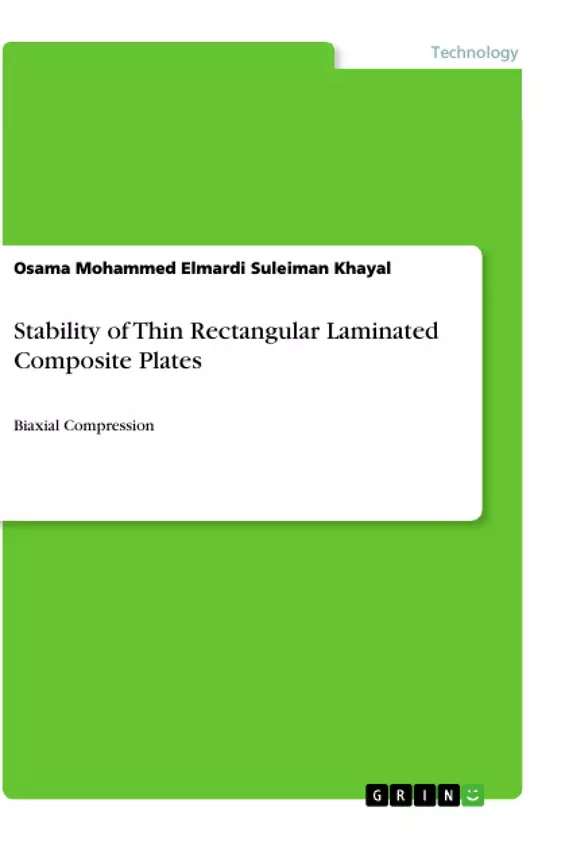The objective of this book is to present a complete and up to date treatment of uniform cross-section rectangular laminated plates on buckling. Finite element (FEM) method is used for solving governing equations of thin laminated composite plates and their solution using classical laminated plate theory (CLPT). Plates are common structural elements of most engineering structures, including aerospace, automotive, and civil engineering structures, and their study from theoretical and experimental analyses points of view are fundamental to the understanding of the behavior of such structures.
Inhaltsverzeichnis (Table of Contents)
- Dedication
- Acknowledgements
- Abstract
- ملخص كتاب
- Chapter 1 Introduction
- Chapter 2 Literature Review
- Chapter 3 Governing Equations of Thin Laminated Composite Plates
- Chapter 4 Finite Element Formulation
- Chapter 5 Numerical Results and Discussion
- Chapter 6 Conclusions and Recommendations
- References
Zielsetzung und Themenschwerpunkte (Objectives and Key Themes)
This book presents a finite element method (FEM) analysis of thin rectangular laminated composite plates subjected to biaxial in-plane compressive loading. The analysis uses the classical laminated plate theory (CLPT), which does not consider shear deformation. The book examines the influence of various factors, such as lamination scheme, aspect ratio, material anisotropy, fiber orientation, and boundary conditions, on the buckling behavior of thin laminates.
- Buckling analysis of thin laminated composite plates
- Application of the finite element method (FEM)
- Influence of lamination scheme and material properties on buckling behavior
- Effects of aspect ratio, fiber orientation, and boundary conditions
- Comparison with theoretical and experimental solutions
Zusammenfassung der Kapitel (Chapter Summaries)
- Chapter 1 Introduction: This chapter provides an overview of the topic of buckling analysis in thin laminated composite plates. It highlights the importance of understanding the behavior of such structures under compressive loading and introduces the key concepts and theories involved in the analysis.
- Chapter 2 Literature Review: This chapter presents a comprehensive review of existing research on the buckling behavior of thin laminated composite plates. It summarizes different analytical and numerical approaches used in previous studies, emphasizing the key findings and limitations.
- Chapter 3 Governing Equations of Thin Laminated Composite Plates: This chapter establishes the theoretical foundation for the analysis by deriving the governing equations of thin laminated composite plates. It focuses on the classical laminated plate theory (CLPT) and its assumptions, including the neglect of shear deformation. The chapter explains how the equations are derived and provides insights into the underlying principles of plate behavior.
- Chapter 4 Finite Element Formulation: This chapter details the implementation of the finite element method (FEM) for the analysis of thin laminated composite plates. It describes the discretization of the plate into elements, the choice of shape functions, and the derivation of element stiffness matrices. The chapter also presents the assembly of the global stiffness matrix and the solution procedure for the buckling analysis.
- Chapter 5 Numerical Results and Discussion: This chapter presents the results of the numerical simulations conducted using the developed FEM model. It analyzes the buckling behavior of thin laminated composite plates under various loading and boundary conditions, investigating the influence of factors such as lamination scheme, material properties, and aspect ratio. The chapter provides detailed discussion and interpretation of the obtained results.
Schlüsselwörter (Keywords)
The key concepts and themes of this book revolve around the buckling analysis of thin rectangular laminated composite plates under compressive loading. The research focuses on the application of the finite element method (FEM) and the classical laminated plate theory (CLPT). The book explores the impact of various factors, such as lamination scheme, aspect ratio, material anisotropy, fiber orientation, and boundary conditions, on the buckling behavior of these structures. This study aims to provide valuable insights into the design and optimization of thin laminated composite plates for various engineering applications.
- Quote paper
- Osama Mohammed Elmardi Suleiman Khayal (Author), 2020, Stability of Thin Rectangular Laminated Composite Plates, Munich, GRIN Verlag, https://www.grin.com/document/593946



